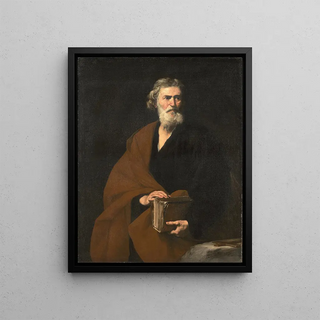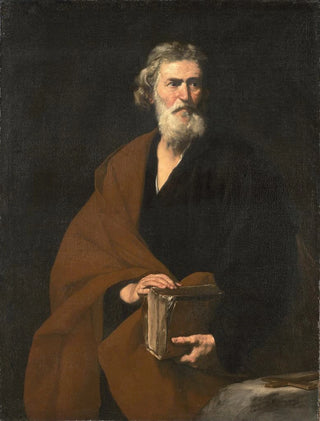Art print | Saint Matthieu - Jusepe de Ribera


View from behind

Frame (optional)
In the fascinating universe of baroque painting, the artwork "Saint Matthieu" by Jusepe de Ribera stands out for its evocative power and dramatic intensity. This depiction of the saint, rooted in a rich and complex artistic tradition, captures the very essence of spirituality and the human condition. Through this piece, Ribera immerses us in a profound dialogue between light and shadow, revealing the inner struggles of the character while celebrating the beauty of the divine. The art print Saint Matthieu - Jusepe de Ribera thus allows us to rediscover this masterpiece, offering a window into the artist's soul and the values of his era.
Style and uniqueness of the work
Ribera's style is characterized by an exceptional mastery of chiaroscuro, a technique that plays a fundamental role in the composition of "Saint Matthieu". The light illuminating the saint's face creates a striking contrast with the shadowed areas that envelop the rest of the scene. This treatment of light not only enhances the three-dimensionality of the figures but also the emotion emanating from the artwork. Matthieu's posture, both humble and imposing, reflects a moment of spiritual revelation, capturing the instant when the saint receives the divine call. The palette of earthy and rich colors, typical of Ribera, reinforces the depth and gravity of the scene, inviting the viewer to reflect on the nature of faith and sacrifice.
The artist and his influence
Jusepe de Ribera, born in Spain in the early 17th century, is often associated with the Caravaggisti movement, which he mastered while developing a personal and distinctive style. His training in Naples, an artistic crossroads of the time, allowed him to absorb Italian influences while remaining faithful to his Spanish roots. Ribera is recognized for his ability to depict religious subjects with rare emotional intensity, but also for his fascination with themes of suffering and redemption. His impact on baroque art is undeniable, inspiring many contemporary and later artists, who saw in him a master at the same time

Matte finish

View from behind

Frame (optional)
In the fascinating universe of baroque painting, the artwork "Saint Matthieu" by Jusepe de Ribera stands out for its evocative power and dramatic intensity. This depiction of the saint, rooted in a rich and complex artistic tradition, captures the very essence of spirituality and the human condition. Through this piece, Ribera immerses us in a profound dialogue between light and shadow, revealing the inner struggles of the character while celebrating the beauty of the divine. The art print Saint Matthieu - Jusepe de Ribera thus allows us to rediscover this masterpiece, offering a window into the artist's soul and the values of his era.
Style and uniqueness of the work
Ribera's style is characterized by an exceptional mastery of chiaroscuro, a technique that plays a fundamental role in the composition of "Saint Matthieu". The light illuminating the saint's face creates a striking contrast with the shadowed areas that envelop the rest of the scene. This treatment of light not only enhances the three-dimensionality of the figures but also the emotion emanating from the artwork. Matthieu's posture, both humble and imposing, reflects a moment of spiritual revelation, capturing the instant when the saint receives the divine call. The palette of earthy and rich colors, typical of Ribera, reinforces the depth and gravity of the scene, inviting the viewer to reflect on the nature of faith and sacrifice.
The artist and his influence
Jusepe de Ribera, born in Spain in the early 17th century, is often associated with the Caravaggisti movement, which he mastered while developing a personal and distinctive style. His training in Naples, an artistic crossroads of the time, allowed him to absorb Italian influences while remaining faithful to his Spanish roots. Ribera is recognized for his ability to depict religious subjects with rare emotional intensity, but also for his fascination with themes of suffering and redemption. His impact on baroque art is undeniable, inspiring many contemporary and later artists, who saw in him a master at the same time






